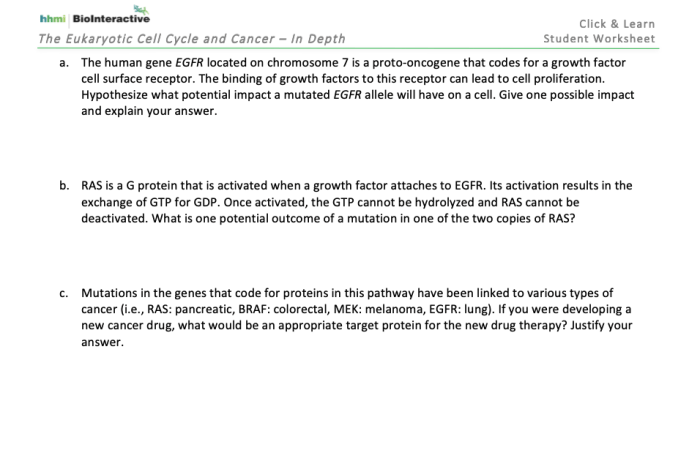HHMI Eukaryotic Cell Cycle and Cancer Answers delves into the intricate relationship between the eukaryotic cell cycle and cancer development. This topic holds profound significance in understanding the fundamental mechanisms underlying the uncontrolled cell division that characterizes cancer. By exploring the dysregulation of cell cycle checkpoints and the role of key regulatory proteins, we unravel the complexities of cancer progression and pave the way for novel therapeutic strategies.
The eukaryotic cell cycle, a precisely orchestrated sequence of events, ensures the faithful duplication and distribution of genetic material during cell division. However, disruptions in this intricate process can lead to genomic instability and tumorigenesis. HHMI Eukaryotic Cell Cycle and Cancer Answers sheds light on the molecular mechanisms underlying these disruptions, empowering us with a deeper understanding of cancer biology.
Eukaryotic Cell Cycle and Cancer: Overview

The eukaryotic cell cycle is a fundamental process in cell division and growth. It consists of distinct stages, including the G1 phase, S phase, G2 phase, and M phase. Key regulatory proteins, such as cyclins and cyclin-dependent kinases (CDKs), control the progression through these stages.
Dysregulation of cell cycle regulation can lead to uncontrolled cell division, a hallmark of cancer development.
Molecular Mechanisms of Cell Cycle Dysregulation in Cancer
Genetic mutations and alterations can disrupt cell cycle regulation, leading to cancer development. Oncogenes, such as Ras and Myc, promote cell division by activating CDKs or inhibiting cell cycle inhibitors. Tumor suppressor genes, such as p53 and Rb, prevent uncontrolled cell division by inhibiting CDKs or promoting cell cycle arrest.
Dysregulated cell cycle checkpoints, such as the G1/S and G2/M checkpoints, can also contribute to genomic instability and tumorigenesis.
Impact of Cell Cycle Alterations on Cancer Treatment, Hhmi eukaryotic cell cycle and cancer answers
Targeting cell cycle dysregulation is a promising strategy for cancer therapy. Cell cycle inhibitors, such as CDK4/6 inhibitors and Wee1 inhibitors, have shown promising results in treating specific types of cancer. Clinical trials are ongoing to investigate the efficacy and safety of these therapies in different cancer contexts.
Future Directions and Challenges in Understanding Cell Cycle and Cancer
Emerging areas of research in cell cycle regulation and cancer include the identification of novel cell cycle targets and the development of more specific and effective therapies. Understanding the complex interplay between cell cycle regulation and other cellular processes is crucial for advancing our knowledge of cancer development and treatment.
Commonly Asked Questions: Hhmi Eukaryotic Cell Cycle And Cancer Answers
What are the key regulatory proteins involved in controlling cell cycle progression?
Cyclins and cyclin-dependent kinases (CDKs) play crucial roles in regulating cell cycle progression.
How can disruptions in cell cycle regulation lead to cancer development?
Dysregulation of cell cycle checkpoints, such as the G1/S and G2/M checkpoints, can lead to genomic instability and tumorigenesis.
What are some examples of genetic mutations that can lead to uncontrolled cell division?
Mutations in genes encoding tumor suppressor proteins, such as p53 and Rb, and oncogenes, such as Ras and Myc, can promote cancer progression by disrupting cell cycle regulation.
How are cell cycle inhibitors used in cancer therapy?
Cell cycle inhibitors, such as CDK inhibitors, are used to target cell cycle dysregulation in cancer therapy by blocking the activity of key regulatory proteins.
What are some emerging areas of research in understanding the role of cell cycle regulation in cancer development and treatment?
Emerging areas of research include investigating the role of microRNAs and non-coding RNAs in cell cycle regulation, exploring the potential of synthetic lethality approaches, and developing novel therapeutic strategies that target cell cycle-related pathways.

